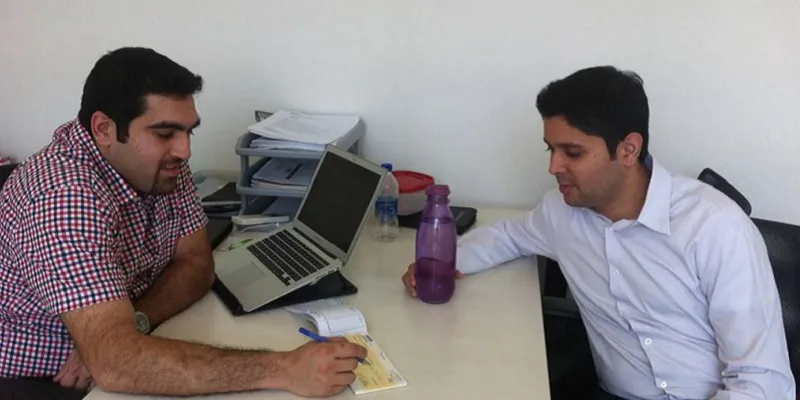Three years, 1,000 customers and Rs 250 crore worth loan disbursement - Capital Float's journey backing the little guy
When Sashank Rishyasringa and Gaurav Hinduja decided to start up in 2013 their aim was to build a very large business not only in terms of scale, but also in terms of the number of people they would be serving. The duo was clear that they wanted to build something where technology could play a role to disrupt the way things were being done for decades. That’s how Capital Float was launched in Bengaluru as a new-age lending solution that operates online and offers unsecured loans to startups, manufacturers, and e-commerce merchants.
“We wanted to build up a business that actually has an impact, where a change can be made to the economy,” says 32-year-old Sashank. In the past three years, they have disbursed loans of close to Rs 250–300 crore and have over 1,000 customers in 40 cities across the country.
It was after looking at different ideas that the duo decided on looking at the financing space. Sashank adds that today from buying a TV to booking a taxi and movie, everything is online. But when it comes to accessing a loan, we still have to go through a long paper-driven process.

Breaking a long-drawn pattern
He adds that most traditional financial institutions talk about the portfolio size. With Capital Float, the duo approached people who they felt had the biggest need and also were the smallest. When the team first thought of this idea, they realised that this kind of approach was in the space of micro-finance and not the SME’s.
“The focus on customer experience, the idea of delighting the customer in a product like loan which brings anxiety and worry – for us it was something exciting to do, and was very different. The second way, which was very different, was that we actually focussed on some of the smallest businesses that need capital to grow,” adds Sashank.
When Sashank and Gaurav came back from Stanford in 2013, they realised that India and the SMEs were not data-poor as they were made out to be. Sashank adds that close to 80 per cent of the SMEs in Bengaluru have Facebook account, 60 per cent use net banking, and all have Aadhaar number.
The two friends saw a sea-change in India in the preceding decade in terms of availability of data and how people had started using technology to run their business deal today, even in a small way.
Transforming the infrastructure
“We felt that it was the right time to get in, because India is going to look a lot like the US in five years. In the US, you see a lot of businesses doing digital lending because the infrastructure is present,” says Sashank.
However, the duo had to begin with building the needed infrastructure and challenging a lot of existing convictions and conventions. The one big convention in India is that you need to meet someone and spend two hours with them to understand whether you will lend to them or not.
The two decided to replace that kind of high-touch personal decision-making that has biases, with machines and data. Much early on, they had the belief that one can create a highly automated, efficient way to assess people that is faster, less biased, because it is done minus the traditional human biases that come with a branch officer or a credit manager that you see in a typical institution.
Redefining a traditional system
“Our idea was to reimagine lending in a fundamentally different way. And even people from a traditional background who joined the team were able to think differently. We also have people from a non-leading background think outside the box when it comes to tech and anything related to it,” adds Sashank.
Also, when they initially started, there was push back saying that they would need branches, as SMEs wouldn’t come online and apply for a loan. Sashank says they don’t have a single branch today and yet receive an enquiry almost every five to 10 minutes on the website from all over the country.
While most people believed that a concept like Capital Float would work only in three or four cities in India, today almost 50 per cent of the organisation’s applications come from Tier II and III cities.
“Sometimes we get application from cities that no one have even heard of, because that person cannot find a bank branch nearby, but they can go online, Google, SME loans and find Capital Float,” says Sashank.
Onboarding the right partners
To ensure that they could break into the market, the duo began partnering with the e-commerce players. In early 2014, the team partnered with Snapdeal, Myntra, Paytm, and Ebay to name a few to see if there was a way they could offer a fast flexible financial offering to their mergers.
They were all pivoting to the market place model, and they were aggregating these long tail of small merchants, selling mobiles, small apparel manufacturing in Tirupur and Ludhiana. That, Sashank adds, was the only way to do GMV. But the question was that the market place has tons of VC money, but how does the small seller get money to grow up?
That is where Capital Float saw a break in the market. In partnership with the e-commerce players, they were able to actually start to make inroads into segments that previously had not taken loans from a bank and were not being served.
They started by saying the only way Capital Float would get credibility is by lending their own equity to get the market place going.
Sashank adds that they had to challenge hypothesis and beliefs that were being held for a long time, and the reality is, at the end of the day, like the person who has the most incentive to challenge the statoscope, will figure a way out if there is a way. Capital Float had raised a Series A round of $13 million in February last year. The round was led by SAIF Partners and Sequoia Capital, with participation from existing investor Aspada.
Adding the numbers
Large banks have no reason to go and break into segments, because they already have 1,000–2,000 portfolios.
Sashank says, “We as a startup were hungry, we want to grow quickly. Our first ports of call were people who did not get a loan from the bank. And there is no such thing as a risky type of business. There are businesses that can be run well and there can be businesses that are run badly. The key in lending is to sort out the businesses that will do well, which is the business per se. If you cannot do that, the only way interesting is that I am not going to touch anyone. So, whenever someone says that I don’t lend to that sector, it means that they have not figured out a way to, what they call the split risk, split the goods from the bad.”
According to Capital Float’s RoC filing in FY2014-15, the total revenue the company made was close to Rs 1.4 crores. Mridul Arora, Principal, SAIF Partners, says that when it comes to FinTech companies, it is important to have good balance between finance and technology. Mridul adds that Gaurav and Sashank bring in a good balance and they had very early on got in people with complimentary skillsets.
Indraneil Bose, Proprietor at Futuretech Solutions, says that Capital Float's customised, inexpensive, and transparent loan solutions helped scale his warehousing capabilities significantly. “The way they approached the product and the tech piece, Capital Float has been able to build a robust loan management system,” adds Mridul.
Capital Float’s revenue model is through interest and fee income. The interest on the loan amount varies anywhere from 16 to 19 per cent. The interest rate, Gaurav adds, would depend on the risk assessment of the individual. The fee income is of a one to two per cent on a processing loan.
A changing landscape
Between Make in India, Jan Dhan, payment banks, small finance banks, RBI and Mundra, Sashank believes the financial landscape in India has seen a sea of change. He adds that the digitisation of commerce is starting to pull the missing middle into the formal economy in a way that it has never happened before.
“We see our SMEs doing business through their smartphone. They get their bank statements and talk to their suppliers through their smartphone. They send us documents through WhatsApp,” says Sashank. By the end of this year, Capital Float aims to be present in 100 cities across the country and across every nook and corner of India.







